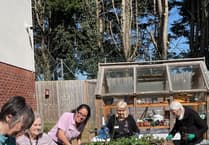David was well supplied with samples and identified the soil components: rock fragments, humus, air, water, organisms and added mineral elements or fertiliser. The type of rock determines the hydrogen ion content or pH of the soil, with iron rich igneous rocks giving a low acidic pH and limestone a higher alkali pH. He demonstrated how to use a kit to determine the soil pH in a garden. The common soil pH is from 4.5 acid to 7.5 alkali. Rhododendrons enjoy the former, while brassicas prefer the latter.
The size of the rock particles determines the pores in the soil. A coarse sandy soil can be very hungry. The organic material helps to glue the soil together and is very beneficial when added to a sandy soil. Adding lime to a clay soil causes the fine particles to flocculate together and improve the crumb structure. It can be added to sweeten the soil in winter. Calcified seaweed is a popular source with extra micronutrients.
Earthw orms are valuable helpers, mixing the organic material that hold the nutrients through a soil. It is very important to add compost and animal manure to a soil to hold nutrients that provide plant food. Fish, blood and bone is a popular fertilizer to add. Plants need nitrogen for leaf growth, phosphates for root development and potash for flowers or fruit. Growmore is a long-established fertilizer containing equal quantities of each.
Members discussed how much soil colour and type varied locally with red soils on the local sandstones and black clay soils on the coal measures. It was agreed that whatever the substrate, increasing the humus content and adding the right fertilizer would produce a better crop.
The next meeting takes place on Wednesday, 11th May when Colin Higgins will talk about ‘Family friendly wildlife gardening’, visitors are very welcome. The Annual Plant Sale is Saturday, May 14th 10.30am – 12.30pm at Kilmersdon Village Hall this is open to anyone looking for bargains to fill their home and garden. Trisha Jordan




Comments
This article has no comments yet. Be the first to leave a comment.